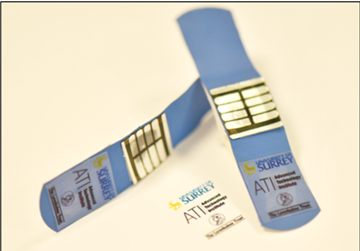There is a current unmet clinical need for a low-cost technology to enable real-time, remote monitoring of complex radiotherapy treatments to improve treatment protocols and consistency in radiation dose administration for radiotherapy patients. Current systems based upon amorphous silicon imaging panels are complex and difficult to implement for advanced radiotherapy. A new premarket technology to address this need required reference-level metrological testing under clinical conditions.
The University of Surrey’s Advanced Technology Institute (ATI) has developed an organic-inorganic hybrid direct conversion X-ray detector that can be fabricated in a flexible format and conformed to the shape of the patient, thereby overcoming disadvantages associated with existing rigid X-ray technologies. This work has now been spun out by Silveray Ltd.
 The performance of the technology was assessed during a project involving NPL, University of Surrey, Cheyney Design Ltd and Silveray Ltd. NPL’s linear accelerator (LINAC) facility provided access to a controlled source of ionising radiation. This enabled the performance of the novel detector to be tested rigorously by comparing the electron beam pattern produced by the LINAC with the performance of Silveray’s flexible X-ray detector. The assessment revealed that its performance is likely to provide comparable angular, linearity and sensitivity performance to conventional X-ray imaging, with the additional benefit of being both low cost and flexible.
The performance of the technology was assessed during a project involving NPL, University of Surrey, Cheyney Design Ltd and Silveray Ltd. NPL’s linear accelerator (LINAC) facility provided access to a controlled source of ionising radiation. This enabled the performance of the novel detector to be tested rigorously by comparing the electron beam pattern produced by the LINAC with the performance of Silveray’s flexible X-ray detector. The assessment revealed that its performance is likely to provide comparable angular, linearity and sensitivity performance to conventional X-ray imaging, with the additional benefit of being both low cost and flexible.
This was published recently in a paper for Advanced Functional Materials.
This project outcome has helped pave the way for the fabrication and integration of a complete autonomous and ultra-sensitive X-ray detector for effective patient-dose measurements during radiotherapy, and provided sufficient confidence in the product for Silveray to win further funding through A4i, which will be used to look at the homogeneity of the detector sensitivity at the nanoscale. NPL’s involvement helped to expediate the sensor development and exploitation path.
Clinical exploitation of the detector will facilitate the widespread adoption of in vivo dosimetry for advanced radiotherapy, improving the administration of radiation dose, and, through proliferation of measurement capability which is conformal to individual patients, also contributing to more wide scale assurance of accuracy in radiotherapy dose delivery. This would not only inform better
treatment planning and radiotherapy delivery but also enable improved tumour control and a reduction in some of the debilitating side effects experienced by millions of patients world-wide, as well as a reduction in the costs associated with managing avoidable side effects.
Silveray was founded by Prof. Ravi Silva CBE in 2018 as a spin-out from the Advanced Technology Institute at Surrey University. The company is developing innovative direct conversion detectors for the X-ray imaging market. Silveray’s core IP and area of expertise are centred around printable semiconductor nanotechnology for X-ray applications.
For more information, please follow us on LinkedIn or visit www.silveray.co.uk
